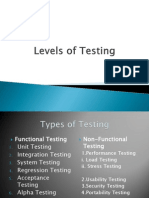0% found this document useful (0 votes)
19 views8 pagesSoftware Testing and Types
The document provides an overview of software testing, defining its purpose, importance, and types, including manual and automated testing, functional and non-functional testing. It outlines various testing levels in the software development lifecycle (SDLC), real-world examples, best practices, and test case creation methodologies. The conclusion emphasizes the significance of a well-planned testing strategy to enhance software quality and reduce costs.
Uploaded by
vqc288x06rCopyright
© © All Rights Reserved
We take content rights seriously. If you suspect this is your content, claim it here.
Available Formats
Download as DOCX, PDF, TXT or read online on Scribd
0% found this document useful (0 votes)
19 views8 pagesSoftware Testing and Types
The document provides an overview of software testing, defining its purpose, importance, and types, including manual and automated testing, functional and non-functional testing. It outlines various testing levels in the software development lifecycle (SDLC), real-world examples, best practices, and test case creation methodologies. The conclusion emphasizes the significance of a well-planned testing strategy to enhance software quality and reduce costs.
Uploaded by
vqc288x06rCopyright
© © All Rights Reserved
We take content rights seriously. If you suspect this is your content, claim it here.
Available Formats
Download as DOCX, PDF, TXT or read online on Scribd
/ 8

















































































